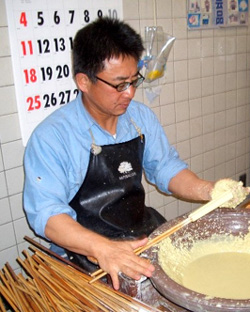| Back
to previous page |
~Past Event ~ 2007 Information |
Wa-rosoku
Demonstration & Workshop by Yasukazu Matsumoto |
|
| About Wa-Rosoku (Japanese candles) |
| Wa-rosoku uses pith wicks from reed grass, and the oil of sumac (haze)
- called tree wax (mokuro) as raw materials. Mokuro is pressed from the outer shell of sumac nuts. Wa-rosoku was introduced
from China in the late 16th century and had peak popularity during
the Edo Period (1603-1867). These candles have a close relationship
to traditional Buddhist culture. The "E-rosoku (flowered candles)" with seasonal flowers painstakingly painted
onto them one by one by artisans have long been used in such colder
regions as the Tohoku and Hokuriku in lieu of
regular flower offerings at home Buddhist altars. From the later 19th
century onward, the introduction of western candles using paraffin
(hydrocarbon-fossil based) led to their steady decline. However, in
recent years they are getting serious new attention as interior decorations,
and today some 30 shops nationwide are manufacturing wa-rosoku by
traditional methods. Tree wax has unique viscosity and other physical properties not seen in paraffin or other waxes. It also has a safetiness that complies with Japan's Food and Health Regulations. Other than in wa-rosoku, it also is being used in a variety of ways, such as in cosmetics, pharmaceuticals, colored pencils, crayons and pastels. It is gaining high regard abroad as "Japanese wax" or "vegetable wax." |
| About Matsumoto Store, Inc. |
| Founded in 1877, the Matsumoto Store Inc. specializes in manufacturing
and sales of "wa-rosoku" (Japanese candles). It is also
the only store in Hyogo Prefecture inviting customers to observe and
learn about the traditional candle making process. At the Matsumoto Store, Japanese candles are manufactured by two methods. The traditional method is called shojo kigake - free forming by hand without molds adding wax layer by layer. A second method is katanagashi - pouring wax into molds. Shojo kigake refers to "candles hand made with plant wax as the raw material", a method that has been traditional since the 17th century. First, a long bamboo stick is inserted into the wick (reed grass wrapped around Japanese paper). The tree wax is heated to a temperature of 40ºC~42ºC. The wax is then applied to the wick repeatedly allowing a drying/solidifying step between applications until the desired size is achieved. Finally, after applying an outer coating of tree wax with a higher melting point (52ºC~55ºC), the wick is exposed at the top, the candle is pulled off the bamboo stick and the length is made uniform by "bottom cutting". Traditional wa-rosoku formed in this way have some special properties such as: 1) suitable for use outdoors even in strong winds, 2) produce less soot than candles made of other materials, and 3) burn evenly and cleanly with little drip due to the use of wax with a higher melting point on the outside layer. Matsumoto Store, Inc. Tel: 81-798-36-6021 FAX: 81-798-26-1338 Website: www.warosoku.com |
|
Back to Top |
| Mr. Yasukazu Matsumoto - Profile |
| Following tradition, Mr. Yasukazu Matsumoto worked for five years
in the banking industry to gain experience outside the family business.
At the age of 28 he assumed the responsibility of leading the Matsumoto
Store, Inc. into the 4th generation as a family operated business
while continuing the traditional wa-rosoku craft. To make the art and crafting of wa-rosoku known to more people, he conducts demonstrations at department stores in Japan. And, in 1995 he exhibited at a traditional crafts fair in Taiwan. Matsumoto san continues his efforts to introduce this traditional art-form abroad. His appearance at 2007 Aki Matsuri was his first trip to the USA. |
|
| Hosting Provided by Pacific Software Publishing, Inc. Copyright © 1998-2015 ENMA |
Back
to Top
|
|


